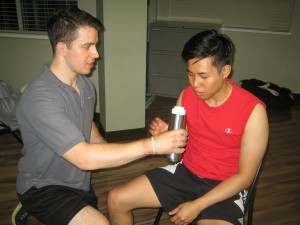Heat cramps is the first of the heat-related illnesses spectrum. It happens when the body overheats. If heat cramps is left untreated, it can progress to heat exhaustion and ultimately, the most life-threatening heatstroke. Heat cramps are the intermittent involuntary spasms of the muscles that are commonly experienced by physically active individuals under the heat of the sun. Heat cramps usually results from the lack of fluid of electrolyte consumption during exercise or hard work in hot weather. It is usually associated with dehydration.
Heat cramps generally affects the arm (biceps and triceps) muscles, the thigh and leg muscles (quadriceps, hamstrings and gastrocnemius), and the core (abdominal wall and back). They frequently occur hours after the physical activity was over, such as at night or during relaxation.
Causes of Heat Cramps
The exact mechanism of heat cramps is still undetermined. What is known is that it is caused by a hot environment. Consider the other causes:
- Inadequate electrolyte consumption, such as sodium, potassium and calcium
- Dehydration
- Strenuous physical activity in the hot weather
- Muscle stress
- Profuse sweating
Risk Factors of Heat Cramps
Although anyone is at risk of experiencing heat cramps during the hot weather, there are several people who are at greater risks, such as:
- Infants and young children because of the big proportion of the body surface area to the overall body weight
- Elderly due the slowed functioning of the body, therefore their body may not adjust as well as their younger counterparts
- It is also important to note that some of their prescription medications and chronic medical conditions may also increase their chances
- Individuals who drink alcohol
- Individuals who exercise or work in hot environments
- Individuals who do not use air conditioners in hot environments
- Drug abusers, particularly ecstasy
Symptoms of Heat Cramps
The main characteristic of heat cramps is the brief, sporadic, involuntary and painful spasms of the muscles. Other symptoms of heat cramps may also manifest, which include:
- Nausea and vomiting
- Sweating
- Fever
- Headache
- Weakness
- Confusion
First Aid Management of Heat Cramps
Although heat cramps is the least serious among the heat-related illnesses, it can still be alarming as leaving it untreated can result to the progression to more serious illnesses.

- Leave the hot environment. Stop any activity that may be causing the sweating. Rest and cool down in a shaded or cool area. If possible, go to an air conditioned room.
- Drink clear fluids that are rich in electrolytes, such as fruit juice or sports drink. Water may also be consumed.
- Eat bananas as they are high in potassium. Do not consume salt tablets as they may result to an upset stomach.
- Gently perform range-of-motion stretching and exercise. Lightly massage the affected muscle area.
- Do not engage in strenuous activities for several hours after the heat cramps disappear. Opt to postpone them until the next day or until well-rested.
- If heat cramps persist, seek medical help. IV fluids may be needed.
The best way to avoid heat cramps is to ensure hydration when one will be exposed to hot environments. To learn how to give appropriate first aid treatment for heat cramps, enroll in first aid courses.
Heat cramps are the intermittent involuntary muscles spasms that occur in individuals who are physically active under the hot environment.
